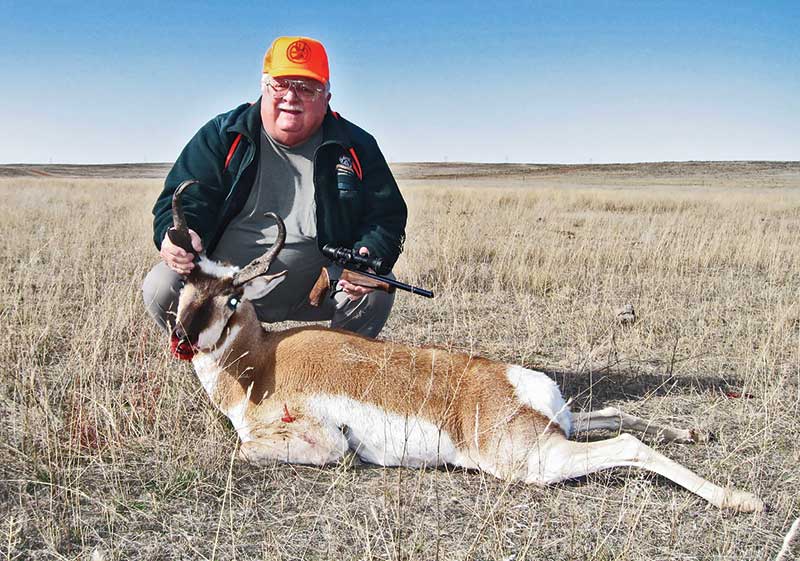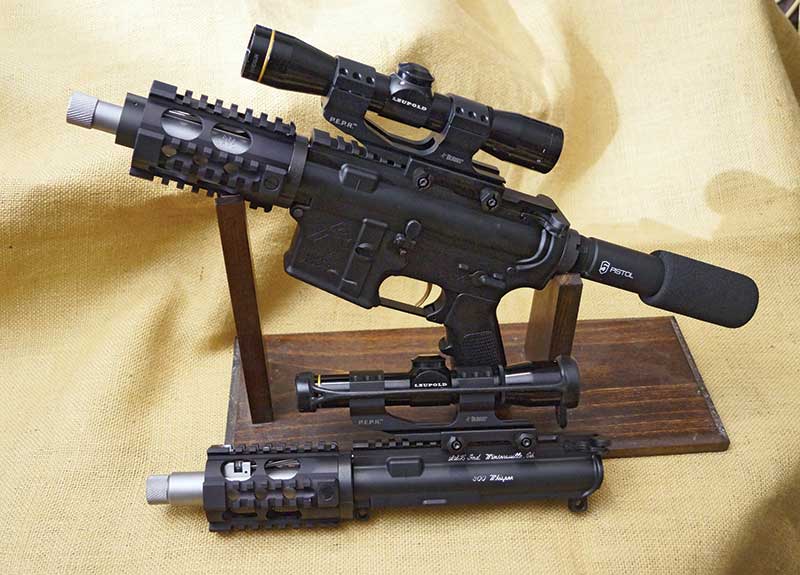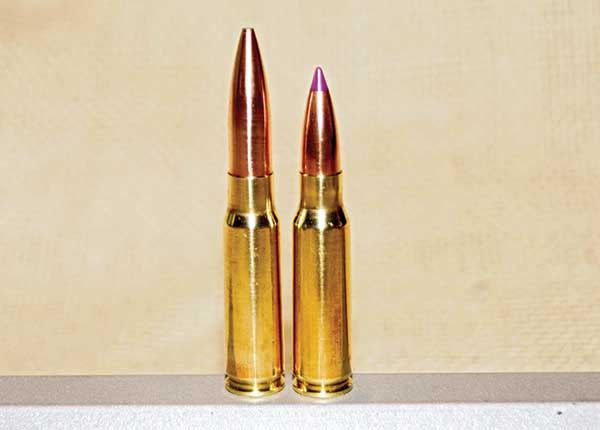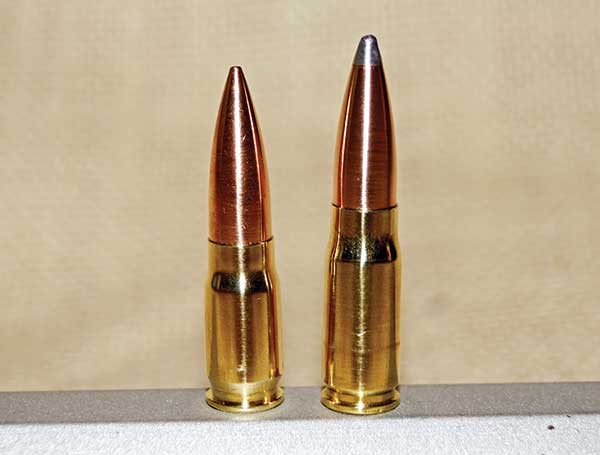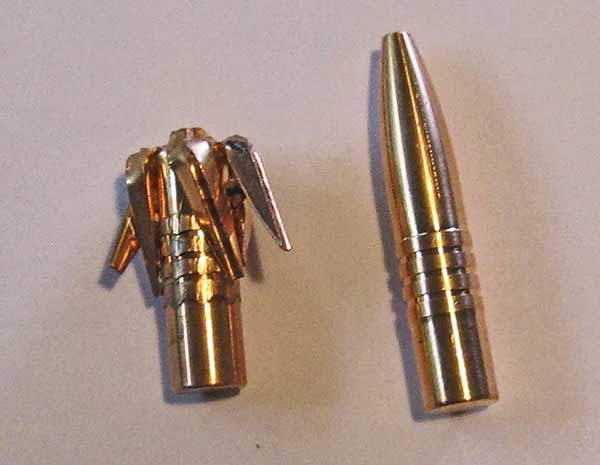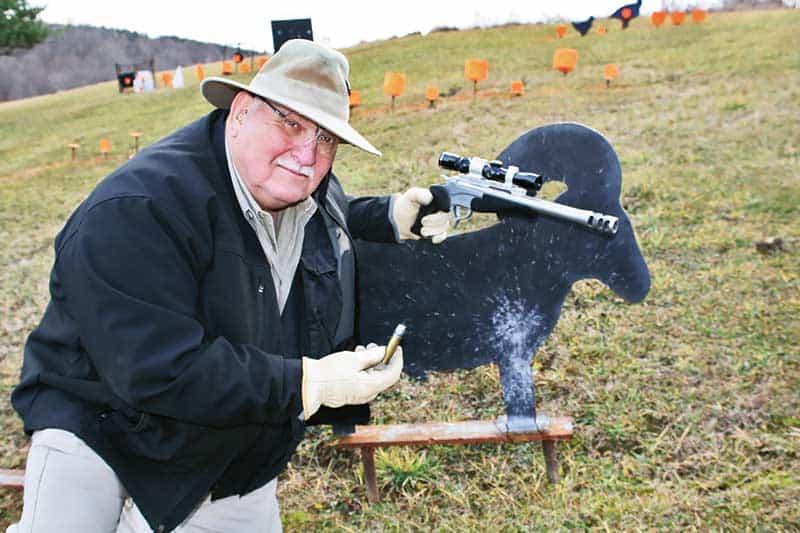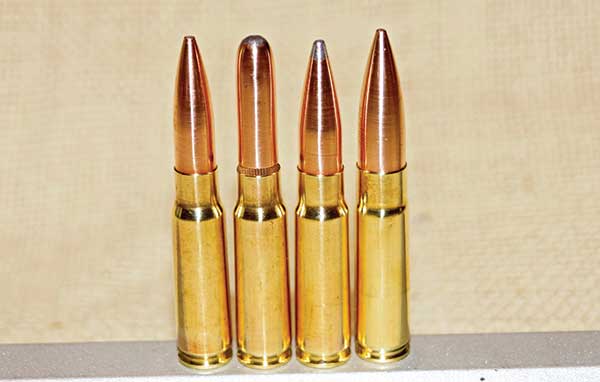JD Jones: A Man And His Cartridges
“Influentially imaginative” doesn’t
begin to describe this ballistic maverick.
In late 1979 I saw an advertisement for a new organization called Handgun Hunters International. I immediately signed up and started writing for the club paper, The Sixgunner. The head man at HHI was JD Jones and we soon became lifelong friends.
I received much experience, exposure, and most importantly, encouragement from JD. In addition to being the editor of The Sixgunner and founder and chairman of HHI, JD also headed SSK Industries, providing custom Contenders mostly chambered for cartridges of his own design.
As I wrote for JD he began providing Contender barrels in both standard chamberings and his custom ones. JD was very well known in the shooting industry and my association with him opened a lot of doors for me. Thanks to JD’s recommendation, I began doing a Silhouette column for American Handgunner in the 1980’s.
If you like what I do, thank JD. If you don’t like it, you can blame him! Without his encouragement and friendship my career wouldn’t have happened. So without further ado, let’s let JD tell us his story, beginning with one of his earliest projects.
Early Days
“After I learned to cast bullets—mainly .38 Special and .45 ACP—I went on to a Smith & Wesson .44 Special and casting Keith bullets and a lot of other stuff, including using a 7mm Rolling Block as a sleeve and rebarreled it with a Thompson SMG 10-inch barrel. That was pretty wimpy, so I used .30-06 cases cut off behind the shoulder to hold .45 ACP 230-grain bullets. That was more like it in the extended chamber. Later to my amazement I found out changing the 7mm to a weaker cartridge in a short barrel was illegal and chucked it into a strip pond.
“About 1960 Lee Jurras and I began serious experimenting with the revolver ammo which ultimately resulted in the Super Vel Cartridge Company. Super Vel was the first company to develop high-performance handgun ammo utilizing all the features of high performance ammo in use today. There was no +P or +P+ back then, but it wasn’t long in coming.
“I killed a lot of pigs and deer with revolvers and semi-autos back then and we were always looking for the ‘better’ tool. When the Contender came out it didn’t take long to find out the additional velocity it gave revolver cartridges in those 10-inch barrels was significant. Bob Gustafsen at T/C helped me a lot with guns and barrels to experiment with. However, I passed a lot of shots I knew I could hit—but didn’t think the performance to affect a quick kill was there even with our greatly improved bullets.
“Lee started the first Handgun Metallic Silhouette shoot in Tucson, Arizona, in the mid-’70’s. The several offhand targets with the shooter having to move was my contribution, and quickly done away with. Between hunting and IHMSA I decided to make up some cartridges—the 6.5, 7mm, and .375 JDJ reamers were ordered at the same time and the barrels all came together at the same time. I showed them to Ken French of Thompson/Center at a shoot in Pennsylvania.
“He was particularly impressed with the .375. It was a little too much for most competition shooters although a few did very well with it. The 6.5 and 7mm JDJs had problems too—target damage. Cheap soft targets took a beating from them. I always felt if you’re going to put on a shoot and take money for it, you either use the proper targets or put up with the damage. Very unpopular opinion. My barrels were soon relegated to the Unlimited Class, where they were hard-pressed to compete against Custom XP’s.
“So my focus turned to hunting and developing ammo suitable for everything from varmints to elephants. Every bore diameter through .50 was experimented with in wildcat cartridge form and perfected in the Contender. The strong .225 Winchester case was used below .30 caliber and the .444 Marlin case from .30 through .416 caliber.
“With the coming of the Encore we found it is capable of handling most of the standard belted magnums but not the non-belted ‘short’ and ‘long’ magnums which gave problems sooner or later. The .30-06 case will equal or surpass the magnums (at least in short barrels) and give much better case life.”
The Whisper
“Whispers are cartridges I invented and copyrighted beginning in 1992. They are capable of excellent accuracy in both subsonic and moderately high-velocity modes. The .300 Whisper was the first, but let’s start with .22 caliber centerfires shorter in length than the .222.
“First, the standard twist rates in most guns will make it difficult to get good subsonic accuracy without rebarreling to a faster twist to stabilize the slow-moving bullets. After doing that, good accuracy is easily achieved with bullets up to around 77 grains in a 1:7-inch twist. After incurring the expense of re-barreling and reloading, you have a nice, quiet, low-powered rifle with little to recommend it over the standard .22 LR.
“It boils down to this—for recreational shooting and small game hunting, I’ll take a suppressed semi-auto such as the Ruger 10/22 (after closing up headspace and giving it a trigger job) over any centerfire subsonic .22. It’s a reasonably accurate semi-auto. Why bother with anything else except for the fun factor of handloading?
Heavy .22 bullets in the real world just don’t offer anything except longer-range accuracy—if that. I had a “swinger” about 40 yards from the back door of my shop and shot it with a great number of heavy .22 caliber jacketed bullets. Frankly, I couldn’t see any real difference in them and a .22 LR.
“Increasing diameter, weight and ballistic efficiency beyond what is possible from the .22 centerfires brings us to 6mm and up, with a maximum bullet weight of around 130 grains. Generally speaking, the 107-grain Sierra provides excellent accuracy and lot-to-lot repeatability which results in consistent subsonic accuracy. Going heavier has given problems. Sometimes they shoot well, sometimes they don’t. Mostly the manufacturers aren’t interested in your accuracy problems and simply know very little—if anything—about subsonic performance.
“In designing the Whisper series, I wanted good accuracy in both sub-sonic and high-velocity mode. I felt it necessary the cartridge be capable of multiple jobs from multiple action types, with the AR-15 at the top of the list.
“For the .300, I started with the .221 Fireball case and the 250-grain Sierra MatchKing (now reduced to 240 grains.) Opening the case mouth to accept a .30-caliber bullet was at most a 2-step job. With a 250-grain bullet seated to 2.240 inches, the AR magazine overall length was achieved, resulting in excellent powder capacity.
“The first step was to chamber a Contender with a 1:8 twist barrel and start shooting over the chronograph. The target velocity of 1,040 fps was easily achieved with a wide variety of powders, which gave varying accuracy, velocity variations and barrel fouling. It was found powders such as AA No. 9, 2400, H-110, WW296 (actually the latter two are the same powder) gave the best overall performance.
“The .300 Whisper is the best of the bunch. It works very well with bullets from 110 grains at high velocity through 240 grains at subsonic velocity. (Actually a special purpose Lehigh 290-grain does very well). It was originally intended to be a satisfactory cartridge for subsonic and moderately high velocity use. I used it in Australia and Africa, taking several hundred animals with it ranging up to around 800 pounds. One morning on a meat hunt I harvested nine kudu cows ranging between about 350 to 400 pounds in weight with nine shots, using the 125-grain Nosler Ballistic Tip. All were shot at around 100 yards and all nine bullets recovered under the hide on the off side weighing from 91 to 94 grains.
“In a 16-inch barrel expect up to 2,400 fps with a 110 and a 125 and to 1,400+ fps with a 240, which equal a good .44 Magnum load in muzzle energy and simply leaves it in the dust in downrange performance. Any decent .30 caliber bullet can work well in the .300 at either high, low or medium velocity, and some of them in all three ranges.
“Some that do very well at one velocity are terrible at another. The 125-grain Nosler Ballistic Tip is one of the best for high-velocity hunting use in the .300. Slow it down to subsonic (1,040 fps) speeds and it is terrible in accuracy. Jack it up to 1,800 fps and the accuracy comes back and will stay great until at least 2,800 fps in the 1:8 twist of the .300.
“I originally experimented with 1:6, 1:7 and 1:8 twist rates in .30 caliber. They all work, but each has its advantages and disadvantages. I selected the 1:8 as the most versatile. IHMSA shooters instantly fell in love with it and it became very popular in the T/C Contender for competition and hunting. T/C barrels have a 1:10 twist and do not do well with subsonic bullets over 180 grains.
“Shortly after the .300 Whisper became public knowledge, the Special Forces purchased some. Suffice to say it has seen combat in a lot of places and I consider the story of the Army wanting a new cartridge developed for the M-16 and going to an outside company to be so much hogwash. Much BS has been written about the Blackout. It is simply the .300 Whisper renamed by AAC-Remington to avoid paying a royalty for use of the name and technology.”
JD Jones’ Accomplishments
• Outstanding American Handgunner
• Handgun Hunter of the Year
• Founded Handgun Hunters International
• Former Editor/Publisher of The Sixgunner
• Past Chairman Outstanding American Handgunner Awards Foundation
• Past President American Pistolsmith Guild
• Hunted six continents with a handgun
• Developed first 320-grain .44 bullet
• Invented T’SOB handgun scope mount
• Invented Whisper cartridges
• Invented muzzlebrakes/suppressors
• Won International Long Range Handgun Competition in Bisley, England
Author’s Note
We have barely scratched the surface on both the man and his cartridges, however we always have to contend with space limitations. You can find more information about JD and his work by going to the SSK website where you will find JD can provide gunsmithing and custom work for just about any handgun or rifle.
SSK Ind., 590 Woodvue Lane, Wintersville, OH 43953, (740) 264-0176, www.sskindustries.com
